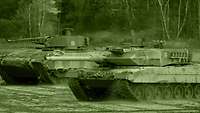Fire control SNCO – at the trigger of all guns
Fire control SNCO – at the trigger of all guns
- Date:
- Place:
- Bergen
- Reading time:
- 3 MIN
“There cannot and will not be howitzers without fire commands. Whenever units require joint fire support, they will receive it”, says Staff Sergeant Jochen Dette. He is a fire control SNCO; he and his fire control team issue the fire commands to the self-propelled howitzers. The fire control team is the ruler of the artillery platoons.
“With artillery, the manoeuvre forces have a reliable partner that supports the battle with precision fires at distances of up to 40 kilometres. An artillery platoon, that means four self-propelled howitzers, receive their fire commands from us via command posts”, explains the 31-year-old soldier. The joint fire support system is highly complex: When the artillery platoon is in position with its four howitzers, the only missing element is the command given by the fire control team. Only then will the howitzers open fire so as to finally support the combat forces with the requested artillery fire.
Destination Munster, with many stops along the way
Today, 325 Artillery Support Battalion is Staff Sergeant Dette’s military home, although it has been a long way to get there. After graduating from secondary school, he underwent basic military training in the Bavarian town of Pfreimd. From the very first day at 104 Tank Battalion in Pfreimd, large and heavy combat vehicles have been a part of his job. “It has always been clear to me that I would join the Bundeswehr. My father, my brother and my friends all supported me in my decision”, he explains. Minden-born Jochen Dette made his first contact with artillery in Augustdorf; however, his stay there was not meant to last. It was only when 215 Armoured Artillery Battalion in Augustdorf was disbanded that he found his way to 325 Artillery Support Battalion in Munster.
The team that directs the fire
Five soldiers and a Fuchs armored transport vehicle make up Dette’s fire control team. He and his counterpart, the second fire control SNCO, share the workload and thus can work in shifts. “Throughout the chain of command, which means from the request for joint fire support right from within the sectors via the command posts to the joint fire support team, the fire control team is the last station before the howitzers”, he explains. An artillery platoon has four howitzers, and Dette is in direct contact with every single one of them. “Commanding two artillery platoons, that is eight howitzers, is not a problem.” The fire control team manages all fire commands or issues orders for the guns to change their firing positions. Apart from voice radio, the fire control team is linked with the howitzers via a digital command and control system. “However, this is precisely one of the greatest challenges”, he describes. The control team is in charge, and as such it is to maintain contact with the crews at all times. If the command and control system were to fail, the team would still have to accomplish the mission. “The howitzers depend on our fire commands. But nothing is impossible. Every shot counts”, he adds with a smile.
Becoming an instructor
The young staff sergeant finds fulfillment in his role as a fire control SNCO: “I have to be very flexible in order to rise to the enormous challenges mentally; this is what motivates me anew every day.” He adds, however, that this is not enough for him. His career path as an SNCO is what drives him to advance both personally as well as professionally. In future, he wants to train young non-commissioned officers and hopes to find a relevant teaching assignment. However, for now he is looking forward to being able to demonstrate his and his fire control team’s capabilities in Lithuania as part of the acknowledged mission enhanced Forward Presence (eFPenhanced Forward Presence). “Gaining multinational experience in Lithuania is very exciting”, Jochen Dette goes on to say.










